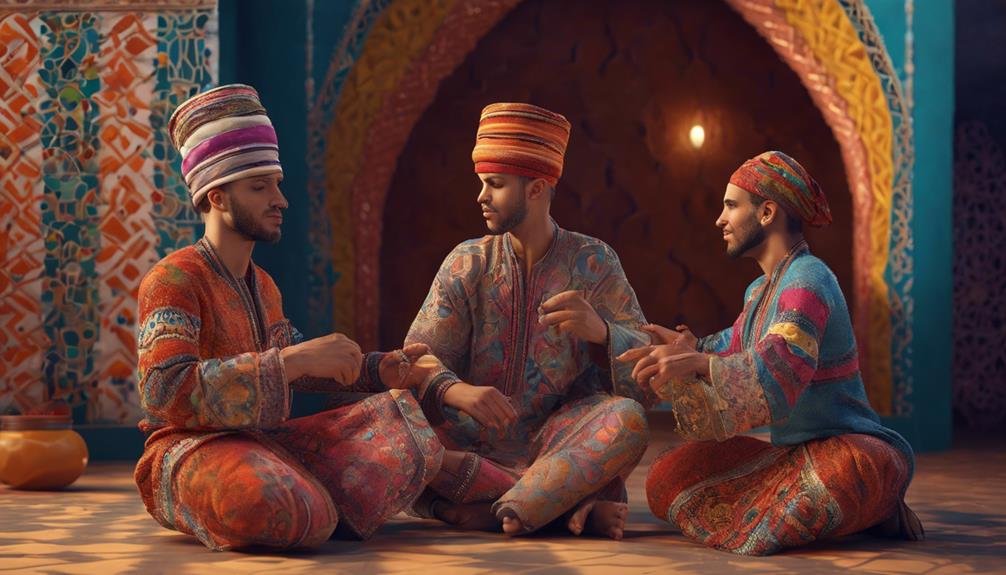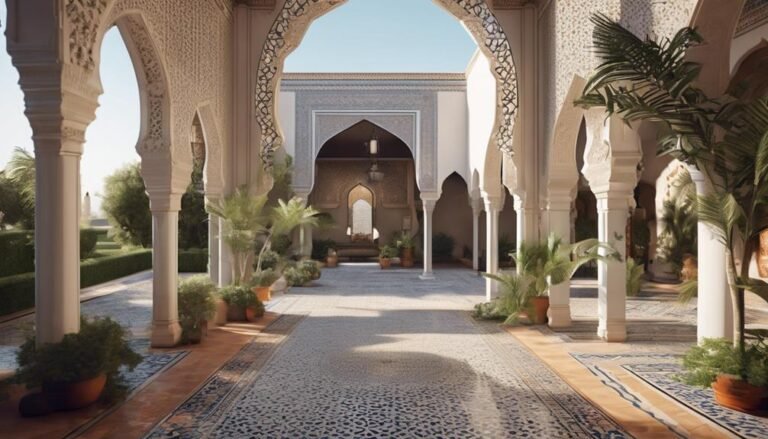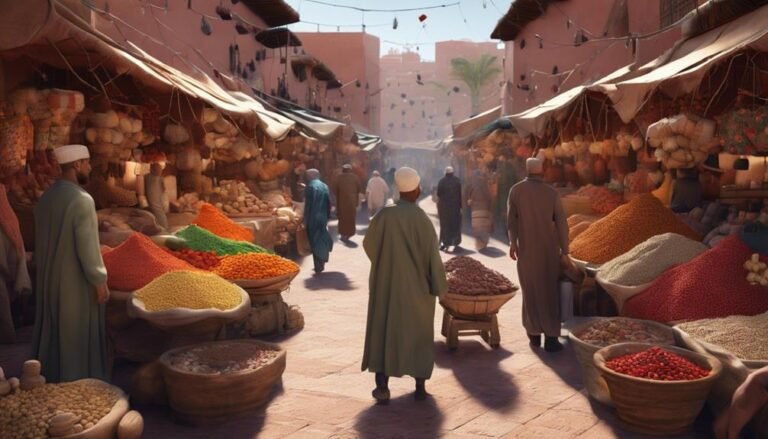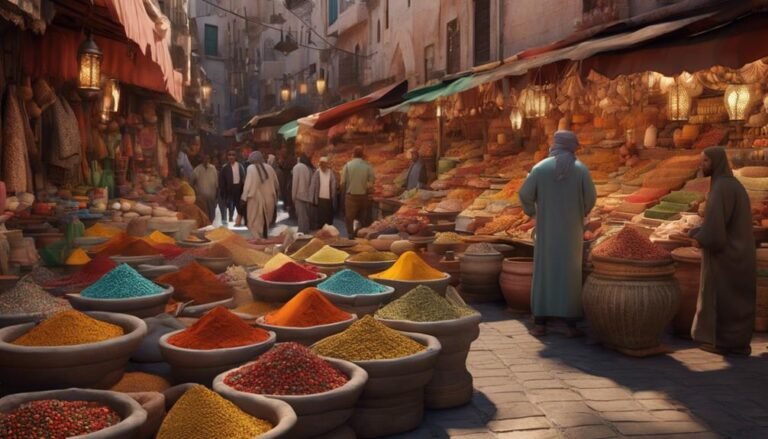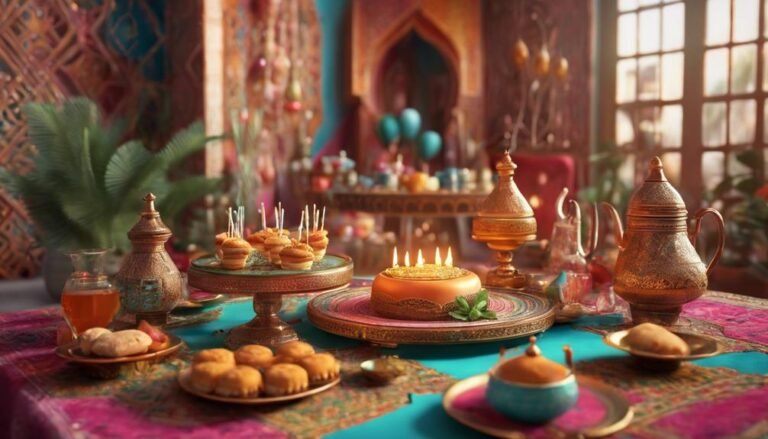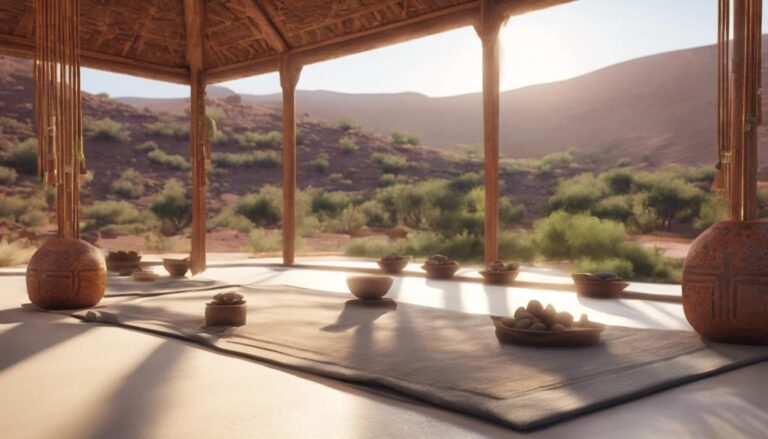Immerse yourself in Morocco's traditional music and dance, where the Oud, guembri, and bendir create a vibrant tapestry. Gnawa music, rooted in Africa's history, combines hypnotic beats with Berber, Arabic, and sub-Saharan influences. Andalusian melodies blend with Moroccan rhythms, reflecting a historical connection. Berber music's intricate melodies and hypnotic chants celebrate North African heritage. Urban Chaabi music fuses tradition with modernity, reflecting Moroccan identity. Dance traditions like Ahidous and Chaabi symbolize unity, while Dakka Marrakchia and Aissaoua Brotherhood showcase unique expressions. Explore the diverse sounds and movements that embody Morocco's cultural richness.
Key Takeaways
- Traditional Moroccan music includes Gnawa, Andalusian, and Berber influences.
- Instruments like Oud, guembri, and bendir play a significant role.
- Chaabi music blends traditional North African rhythms with modern styles.
- Dance traditions like Ahidous, Chaabi, and Dakka Marrakchia showcase cultural diversity.
- Aissaoua Brotherhood combines spiritual devotion with trance music in Morocco.
Musical Instruments of Morocco
When exploring the musical landscape of Morocco, one can't overlook the diverse array of traditional instruments that play a pivotal role in shaping the country's rich cultural heritage. These instruments not only carry the soulful essence of Morocco but also contribute to the intricate tapestry of its music. The traditional melodies and unique rhythms produced by instruments such as the oud, guembri, and bendir are deeply rooted in Morocco's history and traditions.
Instrument craftsmanship in Morocco is a revered art form that has been passed down through generations, with artisans meticulously handcrafting each instrument to perfection. The intricate designs and attention to detail showcase the skill and dedication of these craftsmen, highlighting the cultural significance that these instruments hold within Moroccan society.
Comparatively, each instrument tells a story, reflecting different aspects of Moroccan life and heritage. From the haunting melodies of the flute to the rhythmic beats of the darbuka, these instruments serve as a bridge between the past and the present, keeping Morocco's musical traditions alive for generations to come.
Gnawa Music and Its Origins
Gnawa music in Morocco finds its roots deeply embedded in the historical lineage of the sub-Saharan African slave trade, merging African rhythms with Islamic spiritual traditions. The influences of Berber, Arabic, and sub-Saharan African cultures on Gnawa music create a unique blend of sounds and rituals. This unique blend of influences gives Gnawa music its distinctive character, serving not only as an art form but also as a spiritual medium. The music is accompanied by special instruments and healing ceremonies that contribute to its significance in Moroccan culture.
Gnawa Music Roots
Originating from the rich cultural heritage of Morocco, Gnawa music is deeply intertwined with spiritual traditions and African rhythms. This unique musical genre has evolved over centuries, blending Berber, Arab, and African influences.
Gnawa music is characterized by hypnotic beats, repetitive chants, and the use of traditional instruments like the sintir. The music is often accompanied by mesmerizing dance forms that reflect the spiritual journey and trance-like states experienced by participants.
Gnawa music's evolution can be traced back to the historical roots of enslaved Africans brought to Morocco, where their cultural practices merged with local traditions. The rhythmic patterns and call-and-response elements in Gnawa music draw parallels with other African musical styles, creating a vibrant tapestry of sound and movement.
Cultural Influences on Gnawa
The fusion of Berber, Arab, and African cultural elements has deeply shaped the unique musical identity of Gnawa music, influencing its origins and evolution over time.
This cultural fusion isn't only evident in the music itself but also in the spiritual significance imbued within Gnawa.
The rhythmic patterns present in Gnawa music are a reflection of the diverse influences that have come together to form this distinctive genre. These rhythms, often accompanied by traditional instruments like the guembri and krakebs, play an essential role in the trance rituals associated with Gnawa performances.
Through these rhythmic patterns and trance rituals, Gnawa music serves as a powerful expression of cultural heritage and a mesmerizing art form that continues to captivate audiences worldwide.
Andalusian Music and Its Influence
Influencing the rich tapestry of Moroccan traditional music and dance, Andalusian music captivates with its intricate melodies and rhythmic complexities. Andalusian music, originating from the regions of Andalusia in Spain, has deeply influenced Moroccan musical traditions.
Here are some key points regarding Andalusian music and its influence on Moroccan culture:
- Andalusian Fusion: The fusion of Andalusian melodies with traditional Moroccan rhythms has created a unique musical blend that characterizes much of Moroccan music today.
- Modern Influences: Contemporary Moroccan musicians continue to draw inspiration from Andalusian music, incorporating its elements into modern compositions.
- Cross-Cultural Exchange: The historical ties between Morocco and Andalusia facilitated a cultural exchange that enriched both regions' musical heritage.
- Legacy of Andalusian Music: The preservation of Andalusian music in Morocco highlights the importance of safeguarding traditional musical forms.
- Educational Initiatives: Efforts to educate the younger generation about Andalusian music promote its continuation and appreciation in Moroccan society.
Berber Music Traditions
Immerse yourself in the vibrant tapestry of Berber music traditions, which pulsate with a rich cultural history and distinctive rhythmic patterns. Berber music is deeply rooted in the traditions of the indigenous people of North Africa, reflecting the diverse heritage of the Berber communities across Morocco. The music encompasses a wide array of instruments such as drums, flutes, and stringed instruments, creating a unique sound that's both engaging and essential.
Berber music traditions are characterized by intricate melodies, hypnotic chants, and rhythmic beats that have been passed down through generations. These traditions serve as a window into the ancient customs and beliefs of the Berber people, offering a glimpse into their way of life and cultural identity. The rhythmic beats in Berber music hold a special significance, often accompanying ceremonial rituals, celebrations, and social gatherings.
Compared to other music genres in Morocco, Berber music stands out for its raw energy and authentic expression of Berber heritage. It continues to be a crucial part of Berber culture, preserving age-old traditions and connecting communities through the universal language of music.
Chaabi Music: Popular Urban Sound
Let's explore the vibrant world of Chaabi Music, an urban sound that resonates with the pulse of Morocco.
Discover the roots of Chaabi Music, its distinctive blend of traditional and modern influences, and the rhythmic beats that define its essence.
From the diverse array of musical instruments used to the mesmerizing dance styles inspired by Chaabi, immerse yourself in the rich tapestry of this popular genre.
Chaabi Music Origins
Chaabi music, known for its vibrant rhythms and energetic melodies, has its origins deeply rooted in the urban culture of Morocco. This popular genre of music has evolved over time, blending traditional North African rhythms with modern adaptations to create a unique sound that resonates with audiences both locally and internationally.
When exploring the origins of Chaabi music, it becomes evident that regional variations play a significant role in shaping the style and lyrics of the songs. From the bustling streets of Casablanca to the vibrant neighborhoods of Marrakech, each region brings its own flair to the Chaabi music scene.
The history of Chaabi music is a reflection of the rich cultural tapestry of Morocco.
- Fusion of traditional North African rhythms
- Influence of urban lifestyle on music composition
- Role of storytelling in Chaabi song lyrics
- Impact of migration on Chaabi music evolution
- Connection between Chaabi music and Moroccan identity
Chaabi Musical Instruments
Among the array of musical instruments that contribute to the vibrant and distinctive sound of Chaabi music, the traditional lute known as the 'oud' stands out as a cornerstone of the genre's popular urban sound.
The evolution of Chaabi music has seen modern influences integrate with traditional elements, shaping the musical landscape. In comparison to other Moroccan musical styles, Chaabi instruments like the oud, violin, and hand percussion instruments bring a unique blend of sounds that captivate listeners.
The oud, with its rich history and deep cultural significance, adds a layer of authenticity to Chaabi music that resonates with audiences. As Chaabi music continues to evolve, these traditional instruments maintain their importance, keeping the essence of the genre alive and thriving.
Chaabi Dance Influence
In exploring the multifaceted world of Chaabi music, one can't overlook the profound influence of Chaabi dance on shaping the genre's popular urban sound. The evolution of Chaabi dance has been pivotal in infusing contemporary influences into the music, creating a dynamic fusion of tradition and modernity.
Chaabi dance costumes play a significant role in performances, with intricate designs and vibrant colors adding to the visual spectacle. Regional variations in Chaabi dance styles bring a diverse range of movements and rhythms, reflecting the cultural richness of different areas in Morocco.
The energy and expressiveness of Chaabi dance continue to captivate audiences worldwide, making it a vital component of Morocco's artistic heritage.
- Chaabi dance evolution and contemporary influences
- Chaabi dance costumes and their significance
- Regional variations in Chaabi dance styles
- The cultural richness reflected in Chaabi dance
- Chaabi dance's impact on Morocco's artistic heritage
Ahidous Dance: A Berber Ritual
Rooted in the rich cultural heritage of the Berber people, the Ahidous Dance stands as a revered ritual that embodies centuries-old traditions and beliefs. This traditional dance, deeply ingrained in Berber rituals, holds significant cultural importance in Morocco. The Ahidous Dance is characterized by rhythmic movements, group formations, and symbolic gestures that reflect the unity and solidarity of the Berber community.
To provide a visual representation of the Ahidous Dance, let's explore a comparison between this traditional Berber ritual and other Moroccan dances:
| Ahidous Dance | Other Moroccan Dances |
|---|---|
| Rooted in Berber culture | Influenced by Arab, African, and Andalusian traditions |
| Emphasizes group coordination | Focuses on individual expression |
| Symbolizes community unity | Celebrates diverse cultural influences |
| Involves intricate footwork and hand gestures | Showcases a variety of movements and styles |
Through its distinctive blend of music, movement, and symbolism, the Ahidous Dance continues to be a vibrant expression of Berber identity and heritage in Morocco.
Dakka Marrakchia: Marrakech Street Music
Exemplifying the vibrant soundscape of Marrakech, Dakka Marrakchia pulsates through the streets, enthralling listeners with its rhythmic beats and spirited melodies. This Marrakech street performance holds immense cultural significance, deeply rooted in the traditions of the city. The Dakka Marrakchia dance, with its energetic movements and synchronized drumming, has evolved over time, adapting to modern influences while preserving its authentic essence.
- Historical Roots: Tracing back to traditional celebrations and communal gatherings.
- Community Participation: Involvement of both performers and spectators, creating a lively atmosphere.
- Rhythmic Beats: Drums and percussion instruments setting the pace for the dancers.
- Costumes and Attire: Bright colors and intricate designs adding to the visual spectacle.
- Influence on Contemporary Music: Fusion of Dakka Marrakchia elements into modern Moroccan music genres.
The Dakka Marrakchia not only entertains but also serves as a cultural emblem, showcasing the artistic heritage and liveliness of Marrakech's streets.
Aissaoua Brotherhood and Trance Music
Tracing its origins to the rich cultural tapestry of Morocco, the Aissaoua Brotherhood intertwines spiritual devotion with mesmerizing trance music, engaging audiences with its profound rituals and enchanting melodies. The Aissaoua Brotherhood is known for its ecstatic rituals, where devotees enter trance-like states through repetitive movements and music. This form of music is deeply rooted in Sufi Islamic traditions, showcasing a unique blend of religious fervor and artistic expression.
Compared to other traditional music and dance forms in Morocco, the Aissaoua Brotherhood stands out for its intense spiritual connection and the way it captivates listeners with its hypnotic rhythms. The music played during their rituals serves as a powerful medium for spiritual transcendence, transporting both participants and spectators into a sphere of heightened awareness and connection to the divine.
The Aissaoua Brotherhood's trance music offers a fascinating glimpse into the intersection of spirituality and artistic expression, making it a significant aspect of Morocco's cultural heritage.
Moroccan Wedding Music and Dance
Moroccan Wedding Music and Dance showcase a vibrant fusion of cultural traditions and celebratory rhythms, embodying the joy and unity of marriage ceremonies in Morocco. Traditional wedding customs are deeply rooted in Moroccan culture, with music and dance playing a central role in these celebrations.
Regional dance styles, such as the energetic Berber Ahidous, the graceful Andalusian Nuba, and the lively Chaabi dances, bring a diverse range of movements to the wedding festivities. Music fusion is evident in the blend of traditional instruments like the oud, bendir, and guembri with modern sounds, creating a dynamic and enchanting auditory experience.
The rhythmic beats of drums and hand-clapping invite guests to join in the merriment, fostering a sense of community and togetherness. Through these musical and dance expressions, Moroccan weddings become not just a union of two individuals but a celebration of culture, tradition, and love.
Conclusion
Exploring the rich tapestry of Morocco's traditional music and dance, you'll uncover a world of diverse influences and vibrant expressions.
From the hypnotic rhythms of Gnawa music to the lively beats of Chaabi, each genre reflects the country's cultural heritage and artistic prowess.
Whether you find yourself swaying to the sounds of Andalusian melodies or marveling at the intricate footwork of Ahidous dancers, Morocco's musical traditions will surely captivate your senses and transport you to a world of beauty and rhythm.

The Editorial Team is a passionate group of Morocco enthusiasts dedicated to sharing the beauty, culture, and wonders of this captivating country. With diverse backgrounds and a deep love for travel, we strive to bring you engaging and informative content that inspires your Moroccan adventures. From uncovering hidden gems and sharing local insights to exploring mouthwatering cuisine and showcasing the vibrant lifestyle, our team is committed to providing you with valuable resources and exciting stories that enhance your exploration of Morocco. Join us on this journey as we celebrate the rich heritage and unforgettable experiences that make Morocco truly special.

